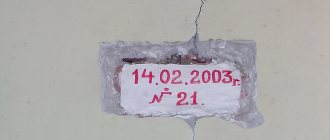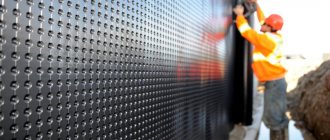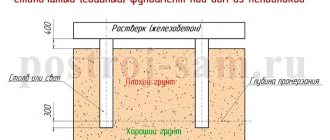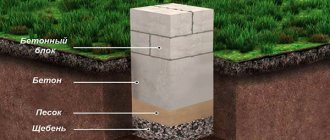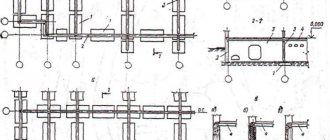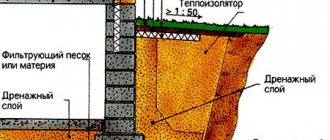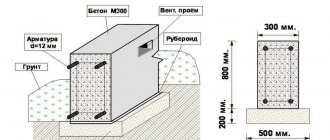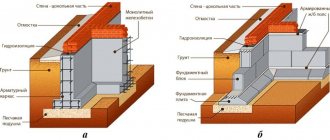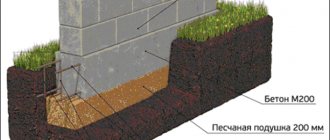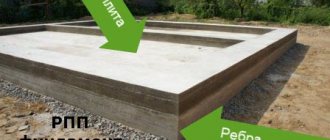The main advantages of a strip foundation are high load-bearing capacity, strength, resistance to all loads with a minimum amount of building materials.
This combination of qualities rightfully makes the tape a leader among all other types of supporting structures.
At the same time, the tape is constantly exposed to multidirectional loads from the soil and influences from the weight of the building, snow, wind loads, etc.
Situations often arise when the strength of the tape is at its limit, especially when seasonal ground movements occur.
Such cases necessitate strengthening the tape, which must be discussed in detail.
Reasons for the destruction of strip foundations
The strip foundation constantly experiences destructive influences.
These include:
- Frosty soil heaving.
- Soil subsidence.
- Construction or excavation work taking place nearby.
- Seasonal ground movements.
- Floods, changes in groundwater levels.
- Presence of slope.
In addition, negative consequences can be caused by:
- Low quality building materials.
- Failure to comply with technological requirements during construction.
- Change in the weight of the building caused by the construction of an additional floor or other reasons.
- Violations of house operating rules.
The listed impacts can occur either individually or in combination, which creates extremely difficult operating conditions for the foundation.
Over time, concrete begins to lose its strength, and additional stress accelerates the destructive processes many times over. The solution to the problem may be to strengthen the strip foundation .
Strengthening the base of the strip base
The basement is an above-ground continuation of the building's foundation. Its structure can be strengthened after the “jacket” of the base has hardened. Horizontal metal rods are tied around the perimeter of the house to the vertical reinforcement of the reinforced concrete belt and the embedded parts of the base. Instead of bulky rods, you can use a steel lattice or chain-link mesh.
Along the entire perimeter of the house, formwork is constructed from wooden panels at the height of the base. The width of the strapping belt is 20–25 cm. The panels are installed vertically at a level and fixed on the outside with bars, which rest at an angle against the upper edge of the formwork.
A horizontal guideline is applied to the wall, starting from the top point of the existing foundation. At the same time, the filling level of the new base is drawn along the walls of the formwork. The cement mortar is prepared with a more liquid consistency for better penetration into cracks and recesses in the base.
The formwork is removed when the concrete has completely hardened. Subsequently, a basement flashing and blind area are made to drain stormwater from the foundation. The concrete surface of the base can be covered with decorative tiles or siding.
Recommended video to watch:
When is amplification required and what is it?
The need to strengthen the foundation arises in different situations:
- When it is planned to build an additional floor, an extension, or otherwise change the size of the house.
- When cracks appear on the walls or foundation strip.
- If the waterproofing of the tape is broken, causing the concrete to crumble.
- Mechanical damage to the tape.
- Rising groundwater levels destroying the tape.
- Aggressive environmental influences.
All these cases require immediate intervention. Reinforcement is an increase in the load-bearing capacity of the strip base by installing additional elements, increasing the cross-section of the strip, injecting special substances or other measures.
The choice of a specific method depends on the condition of the belt, the cause of the problem and the extent of the intervention required. In any case, before starting work, it is necessary to thoroughly examine the structure and make a decision with the participation of experienced specialists.
NOTE!
Self-indulgence in such matters is absolutely excluded, since instead of the expected results, you can get exactly the opposite consequences.
Technologies for strengthening foundations
There are many technologies for strengthening and reconstructing foundations. You can choose a method after a complete picture of the damage to the base is obtained and its causes are clarified.
Not every method can be implemented on your own; in some cases, special equipment and professional help are needed.
We list the main technologies for strengthening the foundation:
- Shotcrete and shotcrete
- Construction of a reinforced concrete jacket
- Providing an additional foundation to unload the existing one, including piles
- Construction of reinforced concrete foundation cages to strengthen their structure and reduce pressure on foundation soils by increasing the area of the base
- Creation of reinforced concrete castings
- Various technologies for strengthening foundation soils - cementation with a composition with a hydraulic binder, both the surrounding soil and the interaction zone
- Installation of soil-cement and drilled injection piles
Diagnosis of the problem
Diagnostics is a set of measures aimed at obtaining complete information about the condition of the supporting structure, the presence of mechanical damage, cracks or deformations.
The condition of the underlying soil, sand cushion and other elements that bear the load from the weight of the house is examined.
The procedure is carried out in stages:
- External inspection of visible parts of the tape . Visual detection of tape damage is carried out from the outside, from the basement (if possible). Looks for visible signs of problems with adjacent layers of soil - subsidence, gullies, etc.
- Underground inspection . The tape is dug around the perimeter, the condition of the trench is checked, the surface of the tape is inspected and any damage that has occurred is detected. The immersion depth of the tape and the base material are assessed.
A defect report is drawn up, which includes all detected damage. A foundation plan is drawn up , on which points of damage, cracks, and deformed areas are noted.
Based on the documentation compiled, a decision is made on measures to solve the problems that have arisen.
During these works, a monthly check of the belt immobility is carried out . Special control beacons are installed on the surface and their condition is recorded.
After a month, their position is checked. If there are no changes, it means that the tape has completed settling.
To perform complex work, unloading of the foundation is required . Its purpose is to transfer the weight of the house to an auxiliary support system, allowing the soil under the tape to be removed for replacement or waterproofing.
Inspection of the strengthened foundation
Cracks on the base and blind area are a signal that the building needs to strengthen the foundation
Before starting large-scale work, it is necessary to identify the factors that caused the process of destruction of the foundation. Eliminating them will help prevent similar phenomena in the future. The first stage of a major overhaul is an external and internal inspection of the base, walls and blind area.
It is necessary to define the following parameters:
- the size and weight of the house as a factor for calculating the load;
- condition of the walls, presence or absence of signs of destruction;
- presence and size of cracks;
- shape, type and size of the foundation;
- strength and external condition of concrete;
- depth;
- the presence of tree roots and voids under the base;
- tendency to deform.
Before drawing up a step-by-step work plan, you should make sure that the shrinkage of the base has completed. To do this, beacons made of plaster or putty are installed on the cracks. If the process progresses, repairs should begin immediately. If you have doubts about the correctness of the diagnosis, it makes sense to invite specialists who will give an accurate conclusion and recommendations on how best and more reliably to strengthen the foundation of an old house with your own hands.
How to strengthen a strip foundation
The actions that need to be taken to strengthen the tape are determined by the size and causes of the damage. In some cases, it is enough to update the waterproofing ; in other situations, a set of complex technical measures is required, such as installing additional supports or expanding the tape.
Let's take a closer look at these methods:
Strengthening a shallow foundation with a concrete jacket
A concrete jacket is a reinforcing concrete casting installed on a problem area of the wall.
To create it, perform the following steps:
- The surface of the tape is exposed, and all soil in the problem area is removed from the trench.
- The waterproofing layer is removed from the concrete tape. The surface of the material must be absolutely clean, as after pouring.
- Transverse holes are drilled through the tape into which reinforcing bars are inserted.
- A reinforcement frame is knitted and welded to rods inserted into the holes of the tape.
- The formwork is being installed.
- Concrete is poured and left for the required time.
- After the curing period has expired, the formwork is removed, the concrete surface is waterproofed and further actions are carried out.
The dimensions of the reinforced concrete jacket depend on the size of the damaged area, but not less than 1 meter.
Creating a concrete frame
The concrete collar forms an additional layer of material on both sides of the tape. The technology resembles the method of installing a reinforced concrete jacket , but an additional layer is poured on both sides of the problem area of the tape.
All actions are carried out both inside and outside the tape . As a result, a significant thickening of the foundation is formed , capable of withstanding high loads.
IMPORTANT!
Many experts express distrust in installing clips. They argue this by the lack of a qualitative connection between the old concrete and the new casting. The processes occurring in fresh material do not allow the layers to join together properly, so the technique is suitable only in the presence of relatively minor damage.
By using piles
The method of strengthening with piles is quite complex and varied. Piles are being installed to create additional support for the tape. They rest on dense layers of soil, stopping subsidence or increasing the bearing capacity of the foundation to accommodate increased loads from extensions or new structural elements of the house.
Different types of piles are used:
- Micropiles.
- Pressable.
- Bored.
- Screw.
- Remote.
Each type of pile performs its own function and is used in certain situations where their use is the best solution to the problem. Thus, screw piles can be installed manually using the most gentle methods possible.
Pressed-in piles require the use of special equipment, so their use for reinforcement is limited.
External piles are installed at some distance from the perimeter of the old tape, then metal beams are passed through it and connected to the piles. As a result, the house appears to be “suspended” on the beams, receiving additional support .
The weight of the building is distributed between the old and new foundations, which allows it to bear increased loads.
With the help of tides
The technique is used to strengthen a tape made of piece elements - brick or rubble stone. The ebb tides are designed to perform the functions of an armored belt .
They are installed on the surface of the tape on both sides, pressed out so that the upper part does not contact the surface of the wall, and the lower part is pressed against it as tightly as possible.
After this, the structure is firmly fixed using jacks. A trench is dug to form a form for pouring concrete. As a result, an additional reinforced concrete layer is formed around the tape, enhancing the load-bearing capacity and strength of the base .
Strengthening with shotcrete
Shotcrete is the process of applying concrete using a special spraying method . Special equipment is used for this. The essence of the method is to supply a dry mixture of cement and sand, called a gunite mixture, under compressed air pressure.
Simultaneously with the supply of the mixture, water is supplied from another tank to mix the mixture. As a result, a layer of dense and durable concrete appears on the reinforced surface , which has improved characteristics compared to conventional types of material.
NOTE!
The technology is complex and requires the involvement of specialists and the use of sophisticated equipment.
Methods of strengthening foundations with special equipment
We list the methods of strengthening foundations that require the use of special equipment and equipment, and reconstruction specialists are used in cases of significant damage and the threat of complete loss of bearing capacity:
- Construction of an off-circuit support or pile foundation. At the same time, the old foundation remains inside the contour, and the load from the house is transferred to new piles or supports through unloading thrust beams, passing through the walls, tape or grillage of the old foundation.
- Reconstruction of the basement using cast-in-place piles in an extendable shell. Steel pipes are immersed in the ground using percussion-rope drilling methods or pressed with jacks. The pile shells, gradually increasing, are immersed to the required depth, then a concrete mixture is pumped into the cavities.
- Bored piles are installed around the house, and sometimes inside the old foundation. Reinforcement cages are installed in drilled wells two meters or more deep and concrete is injected. The reinforced foundation is attached to the piles with through anchor bolts.
Each case of foundation destruction is individual, and so are restoration measures. In some cases, owners cope on their own. In simple cases, all you need is the correct sequence of work and no rush. It is unacceptable to dig around the entire contour of the foundation; you should only work in small sections so that the reinforcement does not create even greater problems for the house.
